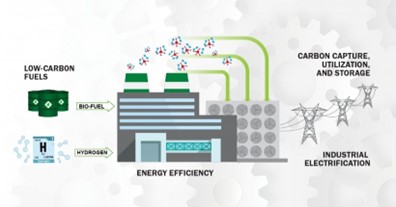When you see a new Toyota Mirai with its rapid 2-minute fuel cell recharge capability, you know its future is promising. Behind the scenes, the US Department of Energy (DOE) is investing up to $6 billion for 33 projects across more than 20 states to decarbonize energy-intensive industries, reduce industrial GHG emissions, support union jobs, revitalize industrial communities, and strengthen the nation’s manufacturing competitiveness. Funded by the Bipartisan Infrastructure Law (BIL) and Inflation Reduction Act (IRA), the projects will create high-quality jobs and help accelerate the commercial-scale demonstration of emerging industrial decarbonization technologies crucial to meeting the Biden-Harris Administration’s climate and domestic manufacturing goals. This achievement would put the American industrial sector on course to reduce its carbon-equivalent emissions by 575 million metric tons by 2050, roughly equal to the emissions generated by all passenger cars on the road in 2020.
The crosscutting decarbonization pillars are energy efficiency, industrial electrification, low-carbon fuels, feedstocks, and energy sources apart from carbon capture, utilization, and storage and direct air capture (DAC) methods. Within its focus on industrial operations, the projects are limited to manufacturing and production while including other facets of industrial operations such as logistics and warehousing.

The target industries include petroleum and refineries, paper and pulp, glass, cement, iron, and steel, which constitute some of the most essential industries critical to a nation’s economy. The following chart shows the breakdown of manufacturing jobs in different industries.
USA Total = 11.4 Million Manufacturing Jobs

Though a great deal of decarbonization progress has been made in sectors like automotive, aerospace, banking, food, retail, pharmaceuticals, and information technology sourced with these raw materials, the materials-focused industries that source them still have opportunities to transition to more capable ESG platforms simply because they still have legacy systems, processes, and infrastructure. For instance, oil and gas companies whose primary output is carbon have a higher stake in investing in postproduction innovation such as carbon capture and storage (CCS) and DAC methods in lieu of a shift in design or manufacturing processes for cleaner energy inventions like electric vehicles (EVs) or fuel cell vehicles (FCVs). Directly rewarding investments like these motivates a nation’s ESG roadmap instead of Pigouvian taxation or penalizing the industries.
The projects should also aim for these industries to become self-sufficient on the power grid, active in engaging communities and stakeholders, transparent and accountable for the money and effort invested, confirm the projects are complaint, and conform to necessary ISO standards to provide a continuous feedback loop during implementation and be in kaizen open loop benchmarked industry standards.
Other key recommendations in the roadmap include:
- Advance early-stage R&D: Further applied science necessary for net zero carbon emissions by 2050, invest in multiple process strategies, continue parallel pathways of electrification, efficiency, low-carbon fuels, carbon capture, utilization, and storage, and alternative approaches.
- Scale through demonstrations: Demonstrate test beds to accelerate and derisk deployment and address process heating. Most industrial emissions come from fuel combustion for heat. Smart manufacturing and advanced data analytics can increase energy productivity in manufacturing processes using IoT, Cloud, and ERP 4.0.
- Integrate solutions, focus on systems impact of carbon reduction technologies on the supply chain and conduct modeling/systems analyses, expand use of lifecycles and techno-economic analyses.
The 33 projects in the aforementioned industries will create an enormous impact in their principal sustainability activities alongside job creation. However, there still remains the rest of the other industries that will need to be included in the future and inclusive of more states.


